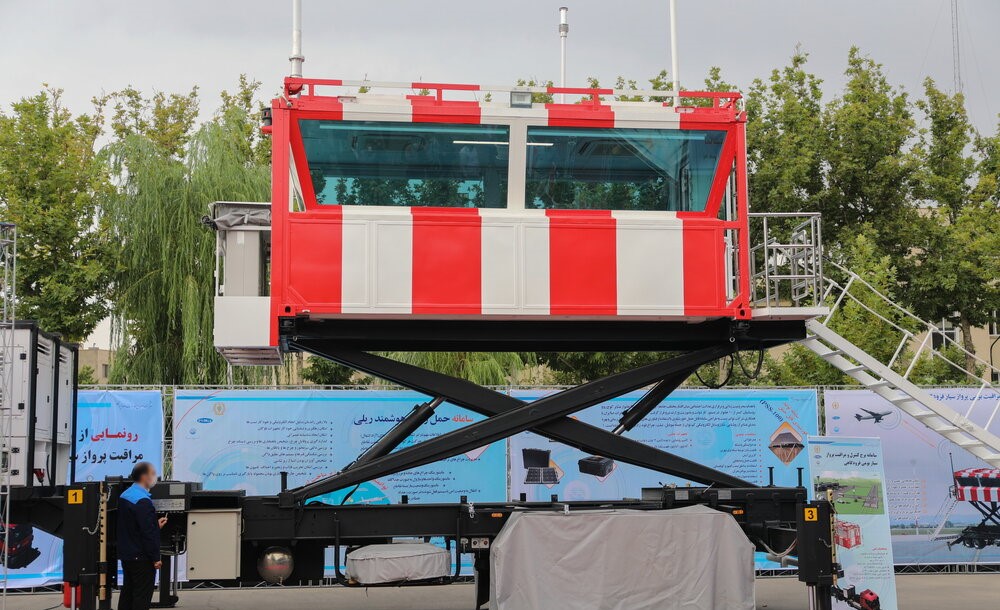Iran’s Defense Ministry has introduced an advanced mobile air traffic control system of domestic production that can be used for all types of flights at airports.
“The new achievement is equipped with domestically-built tools, including air control radio, telephone and radio recording systems, radio switching systems, and network synchronization systems,” Defense Minister Brigadier General Amir Hatami said in a ceremony in Tehran on July 27, according to Iran’s ISNA news agency.
The minister said that the equipment complies with the world’s latest developments and standards, adding that each control tower will help save at least 2 million euros by preventing the imports of the equipment.
Hatami also noted that the new device is equipped with homegrown radio systems using VHF bands as well as recording and GPS systems, saying the mobile tower system can travel in difficult terrains and its repair and maintenance is simple.
The air control tower, which has been developed and manufactured by SAIran, an electronics company run by the Defense Ministry of Iran. Mobile air traffic control systems are air transportable and can be deployed in a short period of time by a small team of personnel after a short training.
The mobile tower is specifically useful for airports without a stationary air traffic control tower, airports with temporary utility, in contingencies such as fires, earthquakes, floods, and wars, or in case the airport infrastructures are damaged or fixed control towers are out of order. It can be installed and brought into operation immediately, and the control system can effectively prevent disruption to air traffic in an emergency.
The presentation ceremony of the Iranian air traffic control system coincided with the recent approach of American warplanes towards an Iranian civil airliner. According to Fars news agency, “two U.S. fighter jets approached a Tehran-Beirut plane operated by Mahan Air over the Syrian sky in a highly risky move and the captain of the Iranian passenger plane was forced to make a sudden change of direction and altitude, causing several injuries”.
Referring to the incident, Iranian Foreign Ministry Spokesman Seyed Abbas Mousavi warned that Tehran will take necessary measures to make Washington regret its action, and said that "it was a terrorist and dangerous move in violation of every international law".
In the meantime, Commander of the Islamic Republic of Iran Air Force (IRIAF), Brigadier General Aziz Nasirzadeh said on the same day at a graduation ceremony of fighter jet pilots at Shahid Del Hamed Air Base in Chabahar, in southern Iran, that new aircraft simulators such as the F-4 will be unveiled in the near future.
He added that the simulators for F-7, F-4E, Sukhoi Su-24, and MiG-29 have been produced and Kowsar fighter jet’s simulator will be manufactured in the near future.
On July 6, the Iranian Air Force brought into service a homegrown simulator system for Russian-made Ilyushin Il-76 fighter jet. Iran also has plans to produce a homegrown simulator system for P3F planes.







 Azerbaijan and Armenia started the process of demarcation of their border on Tuesday, with the installation of the first border markers based on ge...
Azerbaijan and Armenia started the process of demarcation of their border on Tuesday, with the installation of the first border markers based on ge...
 President Aliyev emphasized the critical role of the North-South Transport Corridor in fostering transport cooperation between Azerbaijan and Russi...
President Aliyev emphasized the critical role of the North-South Transport Corridor in fostering transport cooperation between Azerbaijan and Russi...
 Russian Foreign Minister Sergei Lavrov has reasserted that Moscow has no intentions to stop the fighting in Ukraine, even if peace talks commence.
Russian Foreign Minister Sergei Lavrov has reasserted that Moscow has no intentions to stop the fighting in Ukraine, even if peace talks commence.
 Iran has refuted reports of alleged damage to Shimon Peres Negev Nuclear Research Centre located southeast of Dimona, Israel, during the recent air...
Iran has refuted reports of alleged damage to Shimon Peres Negev Nuclear Research Centre located southeast of Dimona, Israel, during the recent air...
 Iran and Pakistan have signed eight cooperation documents in various fields, and agreed to strengthen ties to fight terrorism in the region.
Iran and Pakistan have signed eight cooperation documents in various fields, and agreed to strengthen ties to fight terrorism in the region.



